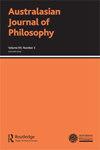二维De Se Chance Defence
IF 1
2区 哲学
0 PHILOSOPHY
引用次数: 0
摘要
*Dianoia哲学研究所高级研究员·dmitri.gallow@acu.edu.au1 LCD与Lewis的主原则不同,尽管它遵循了Lewis接受的条件化更新规则的主原则(见他1999年的例子)。2符号:我在等号上方加一个感叹号,表示等号应该成立,而不是成立。3.问题1:假设我们即将掷硬币,但在掷硬币之前,我们会说:“让我们把硬币的哪一边称为‘Uppy’。”本文章由计算机程序翻译,如有差异,请以英文原文为准。
Two-Dimensional De Se Chance Deference
∗ Senior Research Fellow, Dianoia Institute of Philosophy · dmitri.gallow@acu.edu.au 1 LCD isn’t the same as Lewis’s Principal Principle, though it follows from the Principal Principle given the updating rule of conditionalization, which Lewis accepted (see his 1999, e.g.). 2 Notation: I place an exclamation mark above an equals sign to say that the equality should hold, not that it does hold. 3. Problem #1: suppose that we are about to flip a coin, but before we do so, we introduce the name ‘Uppy’ by saying: “Let’s call whichever side of the coin actually lands up ‘Uppy’.”
求助全文
通过发布文献求助,成功后即可免费获取论文全文。
去求助
来源期刊

AUSTRALASIAN JOURNAL OF PHILOSOPHY
PHILOSOPHY-
CiteScore
2.60
自引率
0.00%
发文量
51
期刊介绍:
The Australasian Journal of Philosophy (AJP) is one of the world''s leading philosophy journals. Founded in 1923, it has been continuously published ever since. It is recognized as one of the best in the analytic tradition, but is not narrow in what it regards as worthy of acceptance. Heavily cited in the general philosophical literature, it is covered by all the major abstracting and indexing services, including the Arts and Humanities Citation Index® which provides access to current and retrospective bibliographic information and cited references found in the world''s leading arts and humanities journals. In addition to Articles and Discussion Notes, the journal publishes Book Reviews and Book Notes as well as occasional commissioned Critical Notices. The journal is read world-wide and has recently published contributions from North and South American, European and Asian as well as Australasian authors.
 求助内容:
求助内容: 应助结果提醒方式:
应助结果提醒方式:


